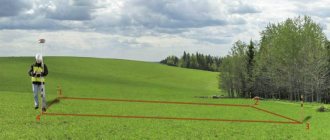Home / Real estate / Land
Back
Published: 11/16/2017
Reading time: 9 min
3
771
After choosing a suitable plot of land, you should not rush to purchase it. Initially, you need to check it for the presence of various encumbrances that could significantly limit its use.
- Definition and legislation
- Bases and methods of application
- Types of encumbrances
- How to find out encumbrances?
- Encumbrance agreement
- Removal of encumbrance
Definition and legislation
Encumbrances on a land plot mean prohibitions and conditions imposed on it that limit its use. Moreover, these restrictions are often not removed with a change in the owner of the site and are tied to the land itself, and not to the owner.
The encumbrance of a site can be understood as:
- restriction of land in circulation (for example, having it as collateral for a mortgage loan);
- providing it for use by other persons (for example, easement);
- limited permitted use (for example, a ban on industrial development in environmental zones).
Article 11.8 of the Land Code describes the ways in which encumbrances may arise on a site:
- in clause 2, the right to unlimited and free use;
- in clause 4, the specifics of the lease agreement;
- clause 5 – methods for establishing the boundaries of easements.
Locally, the legal norms of the Land Code regarding encumbrances on land plots are supplemented by municipal legislative acts.
Types of restrictions and special conditions
Having encumbrances on his property, its owner is limited in the ability to conduct transactions with it and must fulfill certain conditions.
Reason for restrictions:
- A legal action that seizes or orders the installation of an easement;
- A legal document between two or more people. Commissioning of real estate for a period exceeding 12 months, mortgage loan, etc.;
- Legislative act.
Types of encumbrances
Russian legislation contains the following types of encumbrances in relation to plots:
- Easement . This type of encumbrance is established when it is necessary to provide access to a site for a third party or group of persons. An easement can be expressed in the form of the right to pass/pass through a site (for example, if a road to a reservoir runs through the site); the right to lay communications (for example, gas pipes or power lines); the right to use the site for the purposes of reclamation, grazing or driving livestock. An easement can be private (imposed in the interests of a specific person) or public (in the interests of a group of persons). An easement can be imposed for a specific period (for example, for the duration of repair work) or for an unlimited time.
- Mortgage (collateral). When the plot is under mortgage, it is limited in circulation, since it is pledged to the financial institution that issued the money for its purchase. Concluding purchase and sale transactions for land plots is permitted in this case only with the consent of the creditor bank.
- Long-term rental (for a period of one year). By law, lease agreements concluded for a period of at least one year must be registered with Rosreestr. If there is such an encumbrance, the owner has the right to alienate the rights to the plot, but the lease agreement will continue to be valid after the purchase and sale transaction. This fact must be taken into account by a potential buyer.
- Concession. This type of encumbrance has a similar meaning to a lease agreement. According to it, the owner transfers the plot to the concessionaire for use for a certain fee. Typically, such an agreement is concluded for the construction of a building and structure and further profit.
- Judicial arrest as part of enforcement proceedings. It is usually imposed due to the owner's debts. It is assumed that this plot will be sold at auction, and the proceeds will be written off against the resulting debt. Therefore, the owner does not have the right to sell and alienate the site under other agreements.
- Trust management. The encumbrance implies that the operation of the site is carried out by an appointed manager.
- Seizure of land for state needs.
- Encumbrances associated with real estate on a land plot that has the status of cultural monuments.
Sale of land with encumbrances
The sale of land with an encumbrance is not prohibited, except for arrest and a ban on registration actions (Article 37 of the Land Code of the Russian Federation). In the case of a mortgage, permission for the transaction is issued by the mortgagee (creditor). The buyer must be made aware of the rights of third parties to the storage. Information about the encumbrance must be included in the text of the bill of sale.
Clause 3 Art. 37 of the RF Land Code establishes: if the seller lied or did not sufficiently inform the buyer about the encumbrances or restrictions of the site, the latter has the right to demand a discount or termination of the transaction and compensation for the damage caused to him.
The court does not always meet the plaintiffs halfway and terminate the transaction, especially if we are not talking about an encumbrance, but about a restriction under Art. 27 Land Code of the Russian Federation. In one of the recent cases, the plaintiff demanded to cancel the purchase and sale because the defendant did not inform her about the location of the site within the security zone of utility networks (accordingly, nothing can be erected on this part of the land plot, not even a fence). In the extract from the Unified State Register, which she herself requested from Rosreestr, the restriction was not registered.
The court refused to satisfy her demands: such information is publicly available, issued upon request to the district administration, and the plaintiff should have exercised the necessary diligence before purchasing a land plot. In addition, she could not help but notice power lines in the immediate vicinity of the site during her inspection (case No. 2-3119/2018 dated May 14, 2018, Ramensky City Court, Moscow Region).
It is very important to independently examine the site for encumbrances and restrictions before the transaction:
- Order an extract from the Unified State Register of Real Estate from Rosreestr.
- pay close attention to the documents. If the owner has shown a copy of the certificate of ownership, it is recommended to request a “fresh” extract from the Unified State Register of Real Estate. Certificates will not be issued as of 2021, however, previously issued certificates are still valid. The absence of an original document may indicate that the loan is the subject of legal proceedings or is in collateral.
- Some restrictions are not indicated in the extract, for example, the location of the site in a security zone. Information about this should be requested from the administration of the district or settlement; it is given free of charge to everyone.
How to find out encumbrances?
If there are certain encumbrances in relation to the site, then a note about this must be included in the unified register of rights (now it is the Unified State Register of Real Estate).
Rosreestr is responsible for maintaining the specified legal framework. Information from the Unified State Register can be obtained by any interested party and is open.
Therefore, checking the site for the presence of encumbrances is an integral stage before concluding a purchase and sale transaction.
Information on the presence of encumbrances is contained in the Public Cadastral Map of Rosreestr. To obtain the necessary information, simply enter the cadastral number of the land plot into the search bar.
But the information received here is suitable only for the personal purposes of the person concerned and does not serve as official documentary evidence of the fact that there are no restrictions.
A certificate of absence of encumbrances or an extract from the Unified State Register can be obtained in one of the following ways:
- Contact the regional office of Rosreestr.
- Through MFC.
- Submit your request electronically or send it by mail.
To do this, submit an application for an extract from the register indicating the cadastral number of the plot, attach a copy of the passport of the interested person and a receipt with paid state duty. The statement is provided in electronic or paper document format.
The extract contains up-to-date information on cadastral registration and title information. All encumbrances that apply to the site will also be indicated here.
Information about the presence or absence of encumbrances must be contained in the certificate of ownership of the land plot. But it’s better to further protect yourself and request a current extract from the Unified State Register of Real Estate at least a month before the transaction.
What is a land encumbrance?
If we consider this issue more deeply, then an encumbrance is a restriction on actions related to a given plot. So, encumbered land cannot:
- Transfer the property of another person and perform any other registration actions with it.
- Sell to others or pass on to inheritance.
- Other actions related to the transfer of rights to this land.
In other words, this is a seizure of the allotment and after purchase, essentially nothing can be done with it. There can be many reasons for such a procedure, and each of them will have to be studied before removal.
Encumbrance agreement
Since the imposition of encumbrances is subject to mandatory state registration, the parties must formalize their legal relations in contractual form. Depending on the type of encumbrance, they conclude:
- lease or concession agreement;
- trust agreement;
- mortgage agreement.
Such agreements must clearly identify the parties to the relationship: the borrower and the bank, the owner and the lessee, the owner and the concessionaire.
They must contain detailed information about the land plot: its area, cadastral number, permitted use, etc.
In addition to general standard clauses, these agreements include information about the duration of the encumbrance and the procedure for its removal (for example, after making the last payment on the loan). The encumbrance agreement must also specify the grounds for its imposition.
If encumbrances are imposed by a court decision (for example, we are talking about enforcement proceedings or easements), then the conclusion of an agreement is not required.
A one-time payment from the funded part of the pension - how to arrange it correctly? You will find all the information you need about applying for a pension in our article.
Read about raising the retirement age and related changes in payments in this article. We have the most detailed information!
Removing encumbrances from a land plot
Depending on the type of encumbrance, it must be removed in different ways. To terminate a mortgage, as a general rule, the lender and the borrower jointly contact the Rosreestr unit at the location of the land plot. If the mortgagor has a mortgage in hand, he can apply on his own. Removal of the encumbrance is free and occurs within 3 business days.
You need to bring to Rosreestr:
- statement (either joint or from one of the pledge participants);
- mortgage;
- identification documents of applicants;
- power of attorney, if their representatives act on behalf of the participants.
To release the property owner from seizure, they file a claim in court at the location of the property (arbitration court or district court, depending on the owner). It is obligatory to pay a state fee of 300 rubles. for private or 6000 rub. for legal entities (clause 3, clause 1, article 333.19 of the Tax Code of the Russian Federation). A court order authorizing the withdrawal of land from arrest must be submitted to Rosreestr.
An encumbrance arising by virtue of an agreement can be removed with the consent of the person in whose favor it is valid. However, if the other party does not want to waive its rights, the owner will have to go to court (Clause 1 of Article 276 of the Civil Code of the Russian Federation).
Encumbrances and restrictions on houses and plots. How to check and remove them?
When purchasing any countryside real estate, be it land or a house, you should be extremely careful. By hiding important information regarding the property, both parties can suffer: both the owner and the buyer. This may be due to their arrest or encumbrance. What does it mean?
Encumbrances are various conditions or prohibitions that are imposed on land or a house by law or by authorized bodies. The presence of such restrictions may prohibit the alienation of the property altogether, or significantly reduce its value.
Types of encumbrances
Real estate experts divide them into five main types:
Property is rented
Perhaps the most common type of encumbrance. According to the law, a lease agreement must be drawn up between the tenant and the landlord. It defines all aspects of the transaction and is signed by both parties. Only then will it have legal force. Oral agreements are not recognized by law.
After all formalities have been completed, the lessor receives the right to temporarily own and use the property in his own interests, while at the same time certain restrictions are imposed on the owner.
For example, he is obliged, if he wants to sell his property, to notify the tenant without fail, and to transfer to the buyer, along with the house and land, all rights and obligations under the concluded lease agreement.
The object is under trust management (MA)
The owner of the property transfers his property to another person in the trust for a specific period. Ownership of his house and land still remains with him, and the person to whom the property is transferred is obliged to manage it in such a way as to respect the interests of the owner or third parties.
Trust management of real estate must also be formalized in paper form: the parties first draw up an agreement, or it can be a court decision, as a result of which the property is transferred to the trustee.
Existing easement
This is a temporary agreement that establishes a limited right to use someone else's land. It is drawn up when there is a need to use the neighboring territory for travel, during the operation of power lines, laying utility lines and in other similar circumstances.
A private easement between the owner and the future user is drawn up on the basis of an agreement. Public - can be established by law, as well as by other legal acts, taking into account the interests of citizens or in the interests of the state.
Such actions with land plots require mandatory registration with Rosreestr. It should be understood that most often, an easement is not the whim of the owner, but the only possible solution to some general problem of the locality.
Outstanding mortgage loan
The current mortgage agreement on a house or plot is the restrictions that are imposed by the bank on the borrower. Any mortgaged property must be entered into the Unified State Register of Real Estate. And in the documents confirming ownership, the note “Pledge by force of law” is placed.
With the permission of the bank, the mortgaged property can be sold, but the debt obligations under the mortgage automatically transfer to the new owner. In case of non-payment of the debt, such property may be seized in favor of the mortgagee.
Houses and plots that are in arrears in paying taxes and penalties cannot be sold until all arrears are paid off by the owner.
It should be understood that all of the considered types of encumbrances represent serious obstacles to the purchase and registration of such real estate. That is why it is so important for the parties to the transaction to check the real estate for their availability even before they shake hands and begin to make mutual settlements.
Types of restrictions and special conditions
Having encumbrances on his property, its owner is limited in the ability to conduct transactions with it and must fulfill certain conditions.
Reason for restrictions:
- A legal action that seizes or orders the installation of an easement;
- A legal document between two or more people. Commissioning of real estate for a period exceeding 12 months, mortgage loan, etc.;
- Legislative act.
Sometimes, special conditions are established for a property when:
- it cannot be transferred to other persons, also for money;
- a certain time is set for concluding a transaction;
- it is impossible to develop the site and put the facility into operation;
- inheritance is registered and various works on repair or reconstruction of real estate are carried out.
Therefore, before purchasing real estate, it is important not only to read the documentation, but also to study the legislation or consult with an experienced lawyer.
Restricted areas
When a piece of land is located next to a restricted area, restrictions are imposed on it. There are two types of such zones:
- Security . On the territory of which there are water sources, natural reservoirs, and health complexes. They are under the protection and protection of the SES. Industrial production and stations monitoring the hydrological regime may be located within its boundaries;
- Sanitary protective . They are surrounded by objects that have a negative impact on residential areas (chemical industry enterprises or with increased noise and vibration). The zone is determined by the characteristics of the object and the nature of the encumbrance will depend on this. In such a place it is prohibited to build housing and buildings for permanent residence of people.
Different types of zones impose corresponding encumbrances.
How to check a house and land for encumbrances?
Each encumbrance limits the possibility of ownership and does not allow free disposal of real estate. What does it affect?
- A plot of land cannot be sold or transferred for temporary use while a mortgage is issued on it;
- It is possible to sell land with an easement only if the legal order is maintained (the easement will be valid until the expiration of the time for which it was established);
- Under the influence of an encumbrance, the copyright holder does not always have the opportunity to use the land plot for its intended purpose. The ban can be complete or partial.
Important : The encumbrance comes into force only when it is recorded in Rosreestr. Any individual or legal entity can obtain such information about its availability. In this case, it is enough to send a request to the administrative authorities.
- make a request through the MFC (My Documents);
- contact the territorial real estate supervisory authority in charge of the property of interest;
- use your personal account on the government services website (gosuslugi.ru) and submit an application;
To make a request, it is enough to have a cadastral passport or plot number and its location. Based on the results of the application, the applicant is issued an extract with a complete list of all information about the object of interest, including the types of arrests, encumbrances and other restrictions imposed.
How can you remove encumbrances?
Until such time as an encumbrance is imposed on the property, the ability to freely dispose of the property will be limited. Therefore, the owner is interested in having it removed and the entry in Rosreestr cancelled.
Removal of encumbrances can occur for various reasons:
- When changing the category of land and canceling the administrative act;
- Termination of contractual relations;
- Upon expiration of the time for which the encumbrance was registered;
- Upon fulfillment of all obligations;
- A court decision eliminating an encumbrance.
An easement can be forcibly canceled in cases where:
- The terms of the contract are not observed.
Payment deadlines are violated, obstacles are created to the use of the free part of the territory; - Legal norms were violated when introducing an easement;
- There are no grounds for the easement to be preserved (relocation of power lines outside the site, etc.).
To cancel an encumbrance of this type, the copyright holder goes to court and the entry in the Unified State Register is liquidated based on its decision.
How to remove a mortgage encumbrance?
If the owner of the land plot has fully repaid the mortgage debt, he must provide Rosreestr with a bank statement confirming this fact. The entry is canceled based on his request.
Useful video: notary Alexey Komarov on encumbrance of real estate
When purchasing any real estate, it is always necessary to find out whether the property or anything else is legally “clean” before transferring money or signing a sales contract. This is the only way to save yourself from future problems and not pay for other people’s debts. If you suspect an encumbrance on the apartment, quickly check everything; it will decide by itself; there is no point in waiting. If you find yourself in such a situation, remember that previous owners and third parties have every right to challenge and cancel dubious transactions, however, you also have a chance to win, so contact an experienced lawyer as soon as possible.
conclusions
- Potential owners of land plots, especially those intended for housing construction, are frightened by the word easement. However, in fact, an easement on a plot protects the rights not only of the neighbor, but also of the new owner of the encumbered plot. In addition, any encumbrance can be challenged by proving that it has lost its relevance.
- The encumbrance may be a consequence of the convenient location of the site. This means that in the immediate vicinity there are reservoirs, communications, roads and, finally, important government facilities that will be carefully guarded, providing indirect protection to your site.
- Keep in mind that when buying a plot of land without an easement, you may find yourself in a situation where it is necessary to establish one, because the previous owner either ignored the rights of his neighbors or agreed with them verbally.









